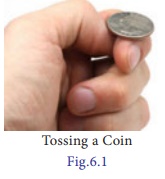Introduction - Random variable | 12th Business Maths and Statistics : Chapter 6 : Random Variable and Mathematical Expectation
Chapter: 12th Business Maths and Statistics : Chapter 6 : Random Variable and Mathematical Expectation
Random variable
Random
variable
Introduction:
Let the random
experiment be the toss of a coin. When ‘n’ coins are tossed, one may be
interested in knowing the number of heads obtained. When a pair of dice is
thrown, one may seek information about the sum of sample points. Thus, we
associate a real number with each outcome of an experiment. In other words, we
are considering a function whose domain is the set of possible outcomes and
whose range is subset of the set of real numbers. Such a function is called random variable.
In algebra, you learned
about different variables like X or Y or any other letter in a
particular problem. Thus in basic mathematics, a variable is an alphabetical
character that represents an unknown number. A random variable is a variable
that is subject to randomness, which means it could take on different values. In
statistics, it is quite general to use X to denote a random variable and
it takes on different values depending on the situation.
Some of the examples of
random variable:
(i) Number of heads, if
a coin is tossed 8 times.
(ii) The return on an
investment in one-year period.
(iii) Faces on rolling a
die.
(iv) Number of customers
who arrive at a bank in the regular interval of one hour between 9.00 a.m and
4.30 p.m from Monday to Friday.
(v) The sale
volume of a store on a particular day.
For instance, the random
experiment ‘E’ consists of three tosses of a coin and the outcomes of
this experiment forms the sample space is ‘S’. Let X denotes the
number of heads obtained. Here X is a real number connected with the
outcome of a random experiment E. The details given below

Outcome (ω) : (HHH) (HHT) (HTH) (THH) (HTT) (THT)
(TTH) (TTT)
Values of X = x :
3 2 2 2 1 1 1 0
i.e., RX
= {0, 1, 2, 3}
From the above said
example, for each outcomes ω, there corresponds a real number X(ω)Since the points of the
sample space ‘S’ corresponds to outcomes is defined for each ω ∈S.
Related Topics